People's Party (United States)
People's Party | |
|---|---|
| Leader |
James B. Weaver William Jennings Bryan Thomas E. Watson |
| Founded | 1891 |
| Dissolved | 1908 |
| Preceded by |
Farmers' Alliance Greenback Party Union Labor Party |
| Merged into |
Farmer-Labor Party Democratic Party Progressive Party |
| Ideology |
Agrarianism Bimetallism Populism |
| Political position | Left-wing |
The People's Party (also known as the Populist Party or the Populists) was an agrarian-populist political party in the United States. For a few years, from 1892 to 1896, it played a major role as a left-wing force in American politics. It was merged into the Democratic Party in 1896; a small independent remnant survived until 1908. It drew support from angry farmers in the West and South. It was highly critical of banks and railroads, and allied itself with the labor movement.[1][2]
Established in 1891, as a result of the Populist movement, the People's Party reached its peak in the 1892 presidential election, when its ticket, composed of James B. Weaver and James G. Field, won 8.5% of the popular vote and carried five states (Colorado, Idaho, Kansas, Nevada and North Dakota), and the 1894 House of Representatives elections, when it took over 10% of the vote. Built on a coalition of poor, white cotton farmers in the South (especially North Carolina, Alabama and Texas) and hard-pressed wheat farmers in the Plains states (especially Kansas and Nebraska), the Populists represented a radical opposition to banks, landowners, local and Eastern elites, railroads, and the gold standard.[3] The party sometimes allied with labor unions in the North and Republicans in the South.
In the 1896 presidential elections the Populists endorsed the Democratic presidential nominee, William Jennings Bryan, adding their own vice presidential nominee. By joining with the Democrats, the People's Party lost its independent identity and rapidly withered away.
Later, after the dissolution of the party, the term populist acquired a generic meaning and throughout most of the 20th century and into the 21st, the term means, "a believer in the rights, wisdom, or virtues of the common people."[4][5]
Formation
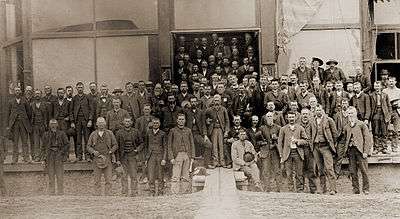
A People's Party grew out of a large mood of agrarian unrest in response to low agricultural prices in the South and the trans-Mississippi West, as well as thought that the "Eastern Elites" were taking advantage of the farmers by charging higher rates on loans and trains.[6] The Farmers' Alliance, formed in Lampasas, Texas, in 1876, promoted collective economic action by farmers and achieved widespread popularity in the South and Great Plains. The Farmers' Alliance ultimately did not achieve its wider economic goals of collective economic action against brokers, railroads, and merchants, and many in the movement advocated for changes in national policy. By the late 1880s, the Alliance had developed a political agenda that called for regulation and reform in national politics, most notably an opposition to the gold standard to counter the high deflation in agricultural prices in relation to other goods such as farm implements.
In 1886, an entirely different "People's Party" elected 6 assemblymen to the Wisconsin State Assembly and 1 senator to the Wisconsin State Senate. However this was a labor party, and by the 1888 elections it was using the Union Labor Party label.
In December 1888 the National Agricultural Wheel and the Southern Farmer's Alliance met at Meridian, Mississippi, where the national farmers convention was held that year. In that meeting they decided to consolidate the two parties pending ratification. This consolidation gave the organization a new name, the Farmers and Laborers' Union of America, and by 1889 the merger had been ratified, although there were conflicts between "conservative" Alliance men and "political" Wheelers in Texas and Arkansas, which delayed the unification in these states until 1890 and 1891 respectively. The merger eventually united white Southern Alliance and Wheel members, but it would not include African American members of agricultural organizations.[7]
During their move towards consolidation in 1889, the leaders of both Southern Farmers' Alliance and the Agricultural Wheel organizations contacted Terence V. Powderly, leader of the Knights of Labor. "This contact between leaders of the farmers' movement and Powderly helped pave the way for a series of reform conferences held between December 1889 and July 1892 that resulted in the formation of the national People's (or Populist) Party."[8]

The drive to create a new political party out of the movement arose from the belief that the two major parties, Democrats and Republicans, were controlled by bankers, landowners and elites hostile to the needs of the small farmer. In February 1892, current and former members of the Greenback Party, Prohibition Party, Anti-Monopoly Party, Labor Reform Party, Union Labor Party, United Labor Party, Workingmen Party, and dozens of other minor parties met in a convention in St. Louis in an attempt to create a single party united against the "money power." Delivering the final speech of the convention, former Congressman Ignatius L. Donnelly, stating, "We meet in the midst of a nation brought to the verge of moral, political, and material ruin. ... We seek to restore the government of the republic to the hands of the 'plain people' with whom it originated. Our doors are open to all points of the compass. ... The interests of rural and urban labor are the same; their enemies are identical."[9]
Later in the year, the party held a national convention chaired by Frances Willard, leader of the WCTU and a friend of Powderly's.[10] Meeting in Omaha, Nebraska, the party nominated a presidential ticket consisting of James B. Weaver and James G. Field. The party's platform, commonly known as the Omaha Platform, called for the abolition of national banks, a graduated income tax, direct election of Senators, civil service reform, a working day of eight hours and Government control of all railroads, telegraphs, and telephones. In the 1892 presidential election, Weaver received 1,027,329 votes. Weaver carried four states (Colorado, Kansas, Idaho, and Nevada) and received electoral votes from Oregon and North Dakota as well.[11]
The party flourished most among farmers in the Southwest and Great Plains, as well as making significant gains in the South, where they faced an uphill battle given the firmly entrenched monopoly of the Democratic Party. Success was often obtained through electoral fusion, with the Democrats outside the South, but with alliances with the Republicans in Southern states like Alabama, North Carolina, Tennessee, and Texas.[12] For example, in the elections of 1894, a coalition of Populists and Republicans led by Populist Marion Butler swept state and local offices in North Carolina, and the coalition would go on to elect Republican Daniel Lindsay Russell as governor in 1896.[13]
Quite separate from the Populists were the Silverites in the western mining states, who demanded Free silver to solve the Panic of 1893. By allowing the coining of silver coins, they hoped to make the value of the money more than what it represented, which would lead to inflation of the currency, and thus, reduce the debt of the farmers to the Eastern Elites. This idea led former Greenback Party members to join the Populist Party.
The Populists followed the Prohibition Party in actively including women in their affairs. Some southern Populists, including Thomas E. Watson of Georgia, openly talked of the need for poor blacks and poor whites to set aside their racial differences in the name of shared economic self-interest. Regardless of these rhetoric appeals, however, racism did not evade the People's Party. Prominent Populist Party leaders such as Marion Butler, a United States Senator from North Carolina, at least partially demonstrated a dedication to the cause of white supremacy, and there appears to have been some support for this viewpoint among the rank-and-file of the party's membership.[14] After 1900 Watson himself became an outspoken white supremacist and became the party's presidential nominee in 1904 and 1908, winning 117,000 and 29,000 votes.
Presidential election of 1896
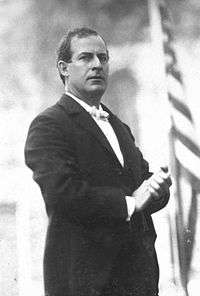
By 1896, the Democratic Party took up many of the People's Party's causes at the national level, and the party began to fade from national prominence. In that year's presidential election, the Democrats nominated William Jennings Bryan, who focused on the free silver issue as a solution to the economic depression and the maldistribution of power. One of the great orators of the day, Bryan generated enormous excitement among Democrats with his "Cross of Gold" speech, and appeared in the middle of 1896 to have a good chance of winning the election, if the Populists voted for him.
The Populists had the choice of endorsing Bryan or running their own candidate. After great infighting at their St. Louis convention they decided to endorse Bryan but with their own vice presidential nominee, Thomas E. Watson of Georgia. Watson was cautiously open to cooperation, but after the election would recant any hope he had in the possibility of cooperation as a viable tool.[15] Bryan's strength was based on the traditional Democratic vote (minus the middle class and German Catholics); he swept the old Populist strongholds in the west and South, and added the silverite states in the west, but did poorly in the industrial heartland. He lost to Republican William McKinley by a margin of 600,000 votes and lost again in a rematch in 1900 by a larger margin. Historians believe this was because of the tactics Bryan used, which had not been used before; he had aggressively "run" for president, while traditional candidates would use "front porch campaigns." [16]
Populist-Republican fusion in North Carolina
In 1894-96 the Populist wave of agrarian unrest swept through the cotton and tobacco regions of the South. The most dramatic impact came in North Carolina, where the poor white farmers who comprised the Populist party formed a working coalition with the Republican Party, then largely controlled by blacks in the low country, and poor whites in the mountain districts. They took control of the state legislature in both 1894 and 1896, and the governorship in 1896. Restrictive rules on voting were repealed. In 1895 the legislature rewarded its black allies with patronage, naming 300 black magistrates in eastern districts, as well as deputy sheriffs and city policemen. They also received some federal patronage from the coalition congressman, and state patronage from the governor.[17]
Collapse
The Populist movement never recovered from the failure of 1896, and national fusion with the Democrats proved disastrous to the party in the South. National alliance with the Democrats sapped the ability of the Populists to fight the Democrats locally in the South. Early on, this was less of an issue in the Western states where Republicans were strong, as the Democratic-Populist alliance was a more natural fit there, but eventually ended the party.
In North Carolina, the state Democratic-party orchestrated propaganda campaign in newspapers across the state, and created a brutal and violent white supremacy election campaign to defeat the North Carolina Populists and GOP, the Fusionist revolt in North Carolina collapsed in 1898, and white Democrats returned to power. The gravity of the crisis was underscored by a major race riot in Wilmington, in 1898, two days after the election. Knowing they had just retaken control of the state legislature, the Democrats were confident they could not be overcome. They attacked and overcame the Fusionists; mobs roamed the black neighborhoods, shooting, killing, burning buildings, and making a special target of the black newspaper.[18] There were no further insurgencies in any Southern states involving a successful black coalition at the state level. By 1900, the gains of the populist-Republican coalition were reversed, and the Democrats ushered in disfranchisement:[19] practically all blacks lost their vote. The Populist/Republican alliance which had governed North Carolina, the only state in which it had any success, fell apart.
Tennessee's Populist Party was demoralized by a diminishing membership, and puzzled and split by the dilemma of whether to fight the state-level enemy (the Democrats) or the national foe (the Republicans and Wall Street). By 1900 the People's Party of Tennessee was a shadow of what it once was.[20] A similar pattern was repeated elsewhere throughout the South, where the Populist Party had previously sought alliances with the Republican Party against the dominant state Democrats, including in Watson's Georgia.
In 1900, while many Populist voters supported Bryan again, the weakened party nominated a separate ticket of Wharton Barker and Ignatius L. Donnelly, and disbanded afterwards. Populist activists either retired from politics, joined a major party, or followed Eugene Debs into his new Socialist Party. In 1904, the party was re-organized, and Thomas E. Watson was their nominee for president in 1904 and in 1908, after which the party disbanded again.
In A Preface to Politics, published in 1913, Walter Lippmann wrote, "As I write, a convention of the Populist Party has just taken place. Eight delegates attended the meeting, which was held in a parlor."[21] This may record the last gasp of the party organization.
Debate by historians over populism
Since the 1890s historians have vigorously debated the nature of Populism. Some historians see a close link between the Populists of the 1890s and the progressives of 1900-1912, but most of the leading progressives (except Bryan himself) fiercely opposed Populism. For example, Theodore Roosevelt, George W. Norris, Robert La Follette Sr., William Allen White and Woodrow Wilson all strongly opposed Populism. It is debated whether any Populist ideas made their way into the Democratic party during the New Deal era. The New Deal farm programs were designed by experts (like Henry Wallace) who had nothing to do with Populism.[22]
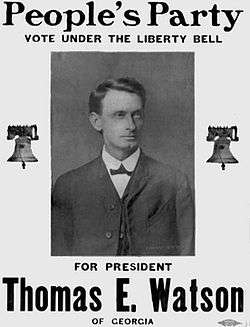
Some historians see the populists as forward-looking liberal reformers. Others view them as reactionaries trying to recapture an idyllic and utopian past. For some they were radicals out to restructure American life, and for others they were economically hard-pressed agrarians seeking government relief. Much recent scholarship emphasizes Populism's debt to early American republicanism.[23] Clanton (1991) stresses that Populism was "the last significant expression of an old radical tradition that derived from Enlightenment sources that had been filtered through a political tradition that bore the distinct imprint of Jeffersonian, Jacksonian, and Lincolnian democracy." This tradition emphasized human rights over the cash nexus of the Gilded Age's dominant ideology.[24]
Frederick Jackson Turner and a succession of western historians depicted the Populist as responding to the closure of the frontier. Turner explained:
- The Farmers' Alliance and the Populist demand for government ownership of the railroad is a phase of the same effort of the pioneer farmer, on his latest frontier. The proposals have taken increasing proportions in each region of Western Advance. Taken as a whole, Populism is a manifestation of the old pioneer ideals of the native American, with the added element of increasing readiness to utilize the national government to effect its ends.[25]
The most influential Turner student of Populism was John D. Hicks, who emphasized economic pragmatism over ideals, presenting Populism as interest group politics, with have-nots demanding their fair share of America's wealth which was being leeched off by nonproductive speculators. Hicks emphasized the drought that ruined so many Kansas farmers, but also pointed to financial manipulations, deflation in prices caused by the gold standard, high interest rates, mortgage foreclosures, and high railroad rates. Corruption accounted for such outrages and Populists presented popular control of government as the solution, a point that later students of republicanism emphasized.[26]
In the 1930s C. Vann Woodward stressed the southern base, seeing the possibility of a black-and-white coalition of poor against the overbearing rich. Georgia politician Tom Watson served as Woodward's hero.[27] In the 1950s, however, scholars such as Richard Hofstadter portrayed the Populist movement as an irrational response of backward-looking farmers to the challenges of modernity. He discounted third party links to Progressivism and argued that Populists were provincial, conspiracy-minded, and had a tendency toward scapegoatism that manifested itself as nativism, anti-Semitism, anti-intellectualism, and Anglophobia. The antithesis of anti-modern Populism was modernizing Progressivism according to Hofstadter's model, with such leading progressives as Theodore Roosevelt, Robert La Follette Sr., George Norris and Woodrow Wilson pointed as having been vehement enemies of Populism, though William Jennings Bryan did cooperate with them and accepted the Populist nomination in 1896.[28]
Michael Kazin's The Populist Persuasion (1995) argued that Populism reflected a rhetorical style that manifested itself in spokesmen like Father Charles Coughlin in the 1930s and Governor George Wallace in the 1960s.
Goodwyn (1976)[29] and Postel (2007) reject the notion that the Populists were traditionalistic and anti-modern. Quite the reverse, they argue, the Populists aggressively sought self-consciously progressive goals. Goodwyn criticizes Hofstadter's reliance on secondary sources to characterize the Populists, working instead with the material generated by the Populists themselves. Goodwyn determined that the farmers' cooperatives gave rise to a Populist culture, and their efforts to free farmers from lien merchants revealed to them the political structure of the economy, which propelled them into politics. The Populists sought diffusion of scientific and technical knowledge, formed highly centralized organizations, launched large-scale incorporated businesses, and pressed for an array of state-centered reforms. Hundreds of thousands of women committed to Populism seeking a more modern life, education, and employment in schools and offices. A large section of the labor movement looked to Populism for answers, forging a political coalition with farmers that gave impetus to the regulatory state. Progress, however, was also menacing and inhumane, Postel notes. White Populists embraced social-Darwinist notions of racial improvement, Chinese exclusion and separate-but-equal.[30]
Populists saw the Panic of 1893 as confirmation that evil global conspiracies and big city villains were to blame. Historian Hasia Diner says:
- Some Populists believed that Jews made up a class of international financiers whose policies had ruined small family farms, they asserted, owned the banks and promoted the gold standard, the chief sources of their impoverishment. Agrarian radicalism posited the city as antithetical to American values, asserting that Jews were the essence of urban corruption.[31]
Electoral history
Presidential elections
| Year | Presidential nominee | Home state | Previous positions | Vice presidential nominee | Home state | Previous positions | Votes | Notes |
|---|---|---|---|---|---|---|---|---|
| 1892 | 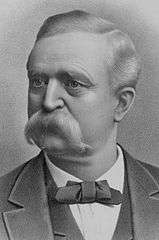 James B. Weaver |
Member of the U.S. House of Representatives from Iowa's 6th congressional district (1879–1881; 1885–1889) Greenback Party nominee for President of the United States (1880) |
 James G. Field |
Attorney General of Virginia (1877–1882) |
1,026,595 (8.5%) 22 EV |
[32] | ||
| 1896 | .jpeg) William Jennings Bryan |
Member of the U.S. House of Representatives from Nebraska's 1st congressional district (1891–1895) |
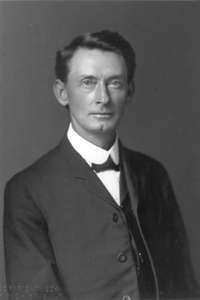 Thomas E. Watson |
Member of the U.S. House of Representatives from Georgia's 10th congressional district (1891–1893) |
222,583 (1.6%) 27 EV |
[33] | ||
| 1900 | .jpg) Wharton Barker |
Financier, publicist | 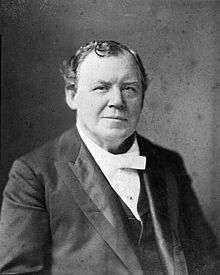 Ignatius L. Donnelly |
Lieutenant Governor of Minnesota (1860–1863) Member of the U.S. House of Representatives from Minnesota's 2nd congressional district (1863–1869) Member of the Minnesota Senate (1875–1879; 1891–1895) Member of the Minnesota House of Representatives (1887–1889; 1897–1899) |
50,989 (0.4%) 0 EV |
[34] | ||
| 1904 |  Thomas E. Watson |
(see above) |  Thomas Tibbles |
Journalist | 114,070 (0.8%) 0 EV |
[35] | ||
| 1908 |  Thomas E. Watson |
(see above) | 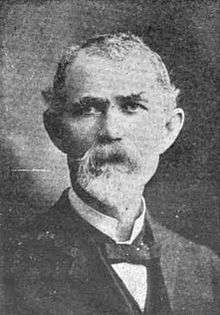 Samuel Williams |
Judge | 28,862 (0.2%) 0 EV |
[36] |
Congressional elections
|
|
- ^ b: Office left vacant when Garret Hobart died on November 21, 1899.
Elected officials
Governors
- Colorado: Davis Hanson Waite, 1893–1895
- Idaho: Frank Steunenberg, 1897–1901 (fusion of Democrats and Populists)
- Kansas: Lorenzo D. Lewelling, 1893–1895
- Kansas: John W. Leedy, 1897–1899
- Nebraska: Silas A. Holcomb, 1895–1899 (fusion of Democrats and Populists)
- Nebraska: William A. Poynter, 1899–1901 (fusion of Democrats and Populists)
- North Carolina: Daniel Lindsay Russell, 1897–1901 (coalition of Republicans and Populists)
- Oregon: Sylvester Pennoyer, 1887–1895 (fusion of Democrats and Populists)
- South Dakota: Andrew E. Lee, 1897–1901
- Tennessee: John P. Buchanan, 1891–1893
- Washington: John Rogers, 1897–1901 (fusion of Democrats and Populists)
United States Congress
Approximately forty-five members of the party served in the U.S. Congress between 1891 and 1902. These included six United States Senators:
- William A. Peffer and William A. Harris from Kansas
- Marion Butler of North Carolina
- James H. Kyle from South Dakota
- Henry Heitfeld of Idaho
- William V. Allen from Nebraska
The following were Populist members of the U.S. House of Representatives:
- Thomas E. Watson, Georgia's 10th congressional district
- Benjamin Hutchinson Clover, Kansas's 3rd congressional district
- John Grant Otis, Kansas's 4th congressional district
- John Davis, Kansas's 5th congressional district
- William Baker, Kansas's 6th congressional district
- Jerry Simpson, Kansas's 7th congressional district
- Kittel Halvorson, Minnesota's 5th congressional district
- William A. McKeighan, Nebraska's 2nd congressional district
- Omer Madison Kem, Nebraska's 3rd congressional district
- Haldor Boen, Minnesota's 7th congressional district
- Marion Cannon, California's 6th congressional district
- Lafayette Pence, Colorado's 1st congressional district
- John Calhoun Bell, Colorado's 2nd congressional district
- Thomas Jefferson Hudson, Kansas's 3rd congressional district
- John Davis, Kansas' 5th congressional district
- William Baker, Kansas' 6th congressional district
- Jerry Simpson, Kansas' 7th congressional district
- William A. Harris, Kansas Member-at-large
- William A. McKeighan, Nebraska's 5th congressional district
- Omer Madison Kem, Nebraska's 6th congressional district
- Alonzo C. Shuford, North Carolina's 7th congressional district
- Albert Taylor Goodwyn, Alabama's 5th congressional district
- Milford W. Howard, Alabama's 7th congressional district
- William Baker, Kansas' 6th congressional district
- Omer Madison Kem, Nebraska's 6th congressional district
- Harry Skinner, North Carolina's 1st congressional district
- William F. Strowd, North Carolina's 4th congressional district
- Charles H. Martin (1848–1931), North Carolina's 6th congressional district
- Alonzo C. Shuford, North Carolina's 7th congressional district
- Albert Taylor Goodwyn, Alabama's 5th congressional district
- Charles A. Barlow, California's 6th congressional district
- Curtis H. Castle, California's 7th congressional district
- James Gunn, Idaho's 1st congressional district
- Mason Summers Peters, Kansas's 2nd congressional district
- Edwin Reed Ridgely, Kansas's 3rd congressional district
- William Davis Vincent, Kansas's 5th congressional district
- Nelson B. McCormick, Kansas's 6th congressional district
- Jerry Simpson, Kansas's 7th congressional district
- Jeremiah Dunham Botkin, Kansas Member-at-large
- Samuel Maxwell, Nebraska's 3rd congressional district
- William Ledyard Stark, Nebraska's 4th congressional district
- Roderick Dhu Sutherland, Nebraska's 5th congressional district
- William Laury Greene, Nebraska's 6th congressional district
- Harry Skinner, North Carolina's 1st congressional district
- John E. Fowler, North Carolina's 3rd congressional district
- William F. Strowd, North Carolina's 4th congressional district
- Charles H. Martin, North Carolina's 5th congressional district
- Alonzo C. Shuford, North Carolina's 7th congressional district
- John Edward Kelley, South Dakota's 1st congressional district
- Freeman T. Knowles, South Dakota's 2nd congressional district
- William Ledyard Stark, Nebraska's 4th congressional district
- Roderick Dhu Sutherland, Nebraska's 5th congressional district
- William Laury Greene, Nebraska's 6th congressional district
- John W. Atwater, North Carolina's 4th congressional district
- Thomas L. Glenn, Idaho's 1st congressional district
- Caldwell Edwards, Montana's 1st congressional district
- William Ledyard Stark, Nebraska's 4th congressional district
- William Neville, Nebraska's 6th congressional district
See also
- Greenback Party
- Left-wing populism
- List of political parties in the United States
- Political interpretations of The Wonderful Wizard of Oz
- Bryant W. Bailey, Louisiana Populist
- William Jennings Bryan, leading Populist politician
- Annie Le Porte Diggs (1853-1916), Populist advocate
- Leonard M. Landsborough, California Populist
- Bring the Jubilee, novel by Ward Moore set in a parallel universe where the Confederacy won the Southern War of Independence and the right-wing Whigs and the left-wing Populists replace the Democratic and Republican parties as the two main political parties in the rump United States, with William Jennings Bryan mentioned as a former three-term president
References
- ↑ Knight (2003), p. 82
- ↑ Pollack (1976), pp. 11–12
- ↑ Schwantes, Carlos A. (1976). Left-wing Unionism in the Pacific Northwest: A Comparative History of Organized Labor and Socialist Politics in Washington and British Columbia. University of Michigan - Labor Unions. p. 180. Retrieved 7 February 2018.
- ↑ Webster's ninth new collegiate dictionary, Springfield, MA: Merriam-Webster, Inc., 1983
- ↑ "Oxford English Dictionary". Oxford English Dictionary Online. 1989. Retrieved 16 March 2018.
- ↑ Foner, Eric (2005). Give Me Liberty! An American History, Volume Two Second Edition. W. W. Norton & Company, New York, London.
- ↑ Hild (2007)
- ↑ Hild (2007), p. 123.
- ↑ Kazin (1995), pp. 27–29
- ↑ Gusfield, Joseph (1963). Symbolic Crusade: Status Politics and the American Temperance Movement The University of Illinois Press, Urbana, Chicago & London, p. 78, 93.
- ↑ "Egad! He Moved His Feet When He Ran". 2008-07-05. ISSN 0190-8286. Retrieved 2018-09-10.
- ↑ http://history.missouristate.edu/wrmiller/Populism/Texts/bibliography.htm
- ↑ William S. Powell, "Marion Butler", Dictionary of North Carolina Biography (1979)
- ↑ Hunt (2003), pp. 3–7
- ↑ Hunt (2003), pp. 4–6.
- ↑ R. Hal Williams, Realigning America: McKinley, Bryan, and the Remarkable Election of 1896 (2010)
- ↑ Helen G. Edmonds, The Negro and Fusion Politics in North Carolina, 1894-1901 (1951). pp 97-136
- ↑ Andrea Meryl Kirshenbaum, "'The Vampire That Hovers Over North Carolina': Gender, White Supremacy, and the Wilmington Race Riot of 1898," Southern Cultures 4#3 (1998) pp. 6-30 online
- ↑ Eric Anderson, Race and Politics in North Carolina, 1872-1901 (1981)
- ↑ Lester (2007)
- ↑ Walter Lippmann, A Preface to Politics, New York and London: Mitchell Kennerley, 1913, p. 275.
- ↑ For a summary or how historians approach the topic see Worth Robert Miller, "A Centennial Historiography of American Populism." Kansas History 1993 16(1): 54-69.
- ↑ See Worth Robert Miller, "The Republican Tradition," in Miller, Oklahoma Populism: A History of the People's Party in the Oklahoma Territory (1987) online edition
- ↑ Clanton (1991), p. xv
- ↑ Frederick Jackson Turner, The Frontier in American History, (1920) p. 148; online edition
- ↑ Martin Ridge, "Populism Revolt: John D. Hicks and The Populist Revolt," Reviews in American History 13 (March 1985): 142-54.
- ↑ C. Vann Woodward, Tom Watson: Agrarian Rebel (1938); Woodward, "Tom Watson and the Negro in Agrarian Politics," The Journal of Southern History, Vol. 4, No. 1 (Feb., 1938), pp. 14-33 in JSTOR
- ↑ Richard Hofstadter, The Age of Reform: From Bryan to F.D.R. (1955)
- ↑ Goodwyn, Lawrence (1976). Democratic Promise: the Populist Moment in America. Oxford University Press.
- ↑ Postel (2007)
- ↑ Hasia R. Diner (2004). The Jews of the United States, 1654 to 2000. U. of California Press. p. 170. ISBN 9780520227736.
- ↑ The ticket won 5 states; its best showing was Nevada where it received 66.8% of the vote.
- ↑ The Populists nominated Bryan, the Democratic nominee, but nominated Watson for Vice President instead of Democratic nominee Arthur Sewall. Bryan and Sewall received an additional 6,286,469 (45.1%) and 149 electoral votes. Bryan's best showing was Mississippi, where he received 91.0% of the vote.
- ↑ The ticket's best result was Texas, where it received 5.0% of the vote.
- ↑ The ticket's best result was Georgia, where it received 17.3%.
- ↑ The ticket's best result was Georgia, where it received 12.6%.
Works cited
- Clanton, O. Gene (1991). Populism: The Humane Preference in America, 1890-1900. Twayne Publishers. ISBN 9780805797442.
- Hild, Matthew (2007). Greenbackers, Knights of Labor, and Populists: Farmer-Labor Insurgency in the Late-Nineteenth-Century South. University of Georgia Press. ISBN 9780820328973.
- Hunt, James L. (2003). Marion Butler and American Populism. University of North Carolina Press. ISBN 9780807862506.
- Kazin, Michael (1995). The Populist Persuasion. Basic Books. ISBN 978-0465037933.
- Knight, Peter (2003). Conspiracy Theories in American History: An Encyclopedia, Volume 1. ABC-CLIO. ISBN 9781576078129.
- Lester, Connie (2006). Up from the Mudsills of Hell: The Farmers' Alliance, Populism, and Progressive Agriculture in Tennessee, 1870-1915. University of Georgia Press. ISBN 978-0820327624.
- Pollack, Norman (1976). The Populist Response to Industrial America: Midwestern Populist Thought. Harvard University Press. ISBN 9780674690516.
- Postel, Charles (2007). The Populist Vision. Oxford University Press. ISBN 9780199758463.
Further reading
Secondary sources
- Ali, Omar H. (2010). In the Lion's Mouth: Black Populism in the New South, 1886-1900. University Press of Mississippi. ISBN 9781604737806.
- Argersinger, Peter H. (2015) [1982]. Populism and Politics: William Alfred Peffer and the People's Party. University Press of Kentucky. ISBN 9780813162003.
- Beeby, James M. (2008). Revolt of the Tar Heels: The North Carolina Populist Movement, 1890-1901. University Press of Mississippi. ISBN 9781604733242.
- Berman, David R. (2007). Radicalism in the Mountain West, 1890-1920: Socialists, Populists, Miners, and Wobblies. University Press of Colorado. ISBN 9781607320067.
- Durden, Robert F. (2015) [1965]. The Climax of Populism: The Election of 1896. University Press of Kentucky. ISBN 9780813162652.
- Formisano, Ronald P. (2008). For the People: American Populist Movements from the Revolution to the 1850s. University of North Carolina Press. ISBN 9780807831724.
- Goodwyn, Lawrence (1978). The Populist Moment: A Short History of the Agrarian Revolt in America. Oxford University Press. ISBN 9780199736096.
- Hackney, Sheldon, ed. (1971). Populism: the Critical Issues. Little, Brown. ISBN 978-0316336901.
- Hicks, John D. "The Sub-Treasury: A Forgotten Plan for the Relief of Agriculture". Mississippi Valley Historical Review, Vol. 15, No. 3 (Dec., 1928), pp. 355–373. in JSTOR.
- Hicks, John D. The Populist Revolt: A History of the Farmers' Alliance and the People's Party Minneapolis, MN: University of Minnesota Press, 1931.
- Jessen, Nathan (2017). Populism and Imperialism: Politics, Culture, and Foreign Policy in the American West, 1890-1900. University Press of Kansas. ISBN 9780700624645.
- Kazin, Michael (2006). A Godly Hero: The Life of William Jennings Bryan. Knopf. ISBN 978-0375411359.
- Knoles, George Harmon. "Populism and Socialism, with Special Reference to the Election of 1892," Pacific Historical Review, vol. 12, no. 3 (Sept. 1943), pp. 295–304. In JSTOR
- McMath, Jr., Robert C. (1993). American Populism: A Social History 1877-1898. Macmillan. ISBN 9780374522643.
- Miller, Worth Robert. "A Centennial Historiography of American Populism." Kansas History 1993 16(1): 54-69. online edition
- Miller, Worth Robert. "Farmers and Third-Party Politics in Late Nineteenth Century America," in Charles W. Calhoun, ed. The Gilded Age: Essays on the Origins of Modern America (1995) online edition
- Nugent, Walter (2013). The Tolerant Populists: Kansas Populism and Nativism (2nd ed.). University of Chicago Press. ISBN 9780226054117.
- Palmer, Bruce (1980). "Man Over Money": the Southern Populist Critique of American Capitalism. University of North Carolina Press. ISBN 978-0-8078-1427-7.
- Peterson, James. "The Trade Unions and the Populist Party," Science & Society, vol. 8, no. 2 (Spring 1944), pp. 143–160. In JSTOR.
- Rogers, William Warren (2001) [1970]. The One-gallused Rebellion: Agrarianism in Alabama, 1865-1896. University of Alabama Press. ISBN 9780817311063.
- Stock, Catherine McNicol (2017) [1996]. Rural Radicals: Righteous Rage in the American Grain (2nd ed.). Cornell University Press. ISBN 9781501714054.
- White, Richard (2017). The Republic for Which It Stands: The United States During Reconstruction and the Gilded Age: 1865–1896. New York: Oxford University Press. ISBN 9780190619060.
- Woodward, C. Vann (2016) [1938]. Tom Watson: Agrarian Rebel. Pickle Partner's Publishing. ISBN 9781787202566. online edition
- Woodward, C. Vann. "Tom Watson and the Negro in Agrarian Politics," The Journal of Southern History, Vol. 4, No. 1 (Feb., 1938), pp. 14–33 in JSTOR
Contemporary accounts
- Gompers, Samuel (July 1892). "Organized Labor in the Campaign". The North American Review. 155 (428): 91–97. Retrieved 2006-10-09.
- Dolph, Senator Joseph N. (January 1893). "Does the Republican Party Need Reorganization?". The North American Review. 156 (434): 54–61. Retrieved 2006-10-09.
- Peffer, Senator William A. (December 1893). "The Mission of the Populist Party". The North American Review. 157 (445): 665–679. Retrieved 2006-10-09.
- Lewelling, L. D. (January 1895). "Problems Before the Western Farmer". The North American Review. 160 (458): 16–21. Retrieved 2006-10-09.
- Stahl, John M. (September 1896). "Are the Farmers Populists?". The North American Review. 163 (478): 266–276. Retrieved 2006-10-09.
- Trent, W. P. (January 1897). "Dominant Forces in Southern Life". The Atlantic Monthly. 79 (471): 42–53. Retrieved 2006-10-09.
- Turner, Frederick J. (April 1897). "Dominant Forces in Western Life". The Atlantic Monthly. 79 (474): 433–443. Retrieved 2006-10-09.
- Peffer, Senator William A. (January 1898). "The Passing of the People's Party". The North American Review. 166 (494): 12–24. Retrieved 2006-10-09.
External links
- 40 original Populist cartoons, primary sources
- Peffer, William A. "The Mission of the Populist Party," The North American Review (Dec 1993) v. 157 #445 pp 665–679; full text online. important policy statement by leading Populist senator
- People's Party Hand-Book of Facts. Campaign of 1898 96 p., official party pamphlet for North Carolina election of 1898
- Populist, republican and Democratic cartoons, 189s election, primary sources
- Populist Party timeline and texts; edited by Professor Edwards, secondary and primary sources
Party publications and materials
- The People's Advocate (1892-1900), digitized copies of the Populist Party's newspaper in Washington State, from The Labor Press Project.
- Populist Cartoon Index. Archived at Missouri State University. Retrieved August 24, 2006.
- Buttons, tokens and ribbons of the Populist Party. Reprinted from Issue 19, Buttons and Ballots, Fall 1998. Retrieved August 26, 2006.
- People's Party Hand-Book of Facts. Campaign of 1898: Electronic Edition. Populist Party (N.C.). State Executive Committee. Reformated and reprinted by the University Library, The University of North Carolina at Chapel Hill.
- Populist materials online courtesy University Library, The University of North Carolina at Chapel Hill.
Secondary sources
- The Populist Movement in the United States by Anna Rochester, 1943.
- Farmers, the Populist Party, and Mississippi (1870-1900). By Kenneth G. McCarty. Published by Mississippi History Now a project of the Mississippi Historical Society. Retrieved August 24, 2006.
- The Populist Party in Nebraska. Published by the Nebraskastudies.org, a project of the Nebraska Department of Education.
- Fusion Politics. The Populist Party in North Carolina. A project of the John Locke Foundation. Retrieved August 24, 2006.
- The Decline of the Cotton Farmer. Anecdotal account of rise and fall of Farmers Alliance and Populist Party in Texas.

.svg.png)